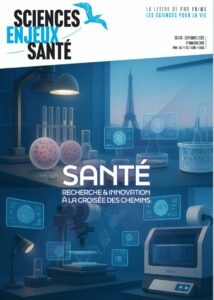
European Research Area policy agenda, Regulatory risk decision-making, Frameworks for integrating NAMs, Human OoC and more
News on non-animal methods
JUNE 02 - 06, 2025NEWS, REPORTS & POSITION STATEMENTS
1. European research area policy agenda for the next three years
The Council has reached a political agreement on a council recommendation to adopt the European Research Area (ERA) Policy Agenda 2025 – 2027. The ERA policy agenda is a comprehensive roadmap for enhancing Europe’s research and innovation (R&I) ecosystem, addressing key challenges like knowledge mobility, sustainability and international competitiveness, while ensuring measurable outcomes and broad voluntary participation by Member States and stakeholders.
2. Ethical principles for regulatory risk decision-making
Risk assessors, managers, and decision-makers are responsible for evaluating diverse human, environmental, and animal health risks. Although the critical elements of risk assessment and management are well-described in national and international documents, the ethical issues involved in risk decision-making have received comparatively little attention to date.
To address this aspect, a new article elaborates fundamental ethical principles designed to support fair, balanced, and equitable risk-based decision-making practices. The ten principles — autonomy, minimize harm, maintain respect and trust, adaptability, reduce disparities, holistic, fair and just, open and transparent, stakeholder engagement, and One Health lens — demonstrate how public sector values and moral norms (i.e., ethics) are relevant to risk decision-making.
Read the article in Regulatory Toxicology and Pharmacology
3. Unlocking the future of environmental safety : A framework for integrating NAMs in decision-making
Traditional regulatory frameworks for assessing the environmental safety of chemicals have historically focused on evaluating in vivo data from standard ecologically representative species. However, there is now a strong regulatory and ethical push towards adopting non-animal approaches that incorporate novel methodologies and enhance the mechanistic understanding of toxicological responses across various species. Despite this progress, their implementation in environmental risk assessment remains limited.
In a recent article, Rivetti et al. propose a conceptual framework for conducting safety assessments that leverages mechanistic data, extending beyond traditional types, to inform environmental safety decisions. Evaluated with three case studies, this approach aims to support the application of new approach methodologies in environmental risk assessment, without the need for generating additional animal data.
Read the article in the NAM journal
4. DNT as a case example for a 6‑step framework for the sustainable regulatory implementation of NAMs
New Approach Methodologies (NAMs) are advancing toxicology by offering reliable, human-relevant alternatives to traditional animal methods.
This review, conducted by DNTOX with the SCAHT — Swiss Centre for Applied Human Toxicology, outlines a six-step framework guiding NAMs from development to regulatory approval, using the Developmental Neurotoxicity (DNT) in vitro battery (IVB) as an example, and highlighting the central role of CROs like DNTOX for regulatory uptake of NAMs.
Read the article in Current Opinion in Toxicology
5. Report Panel on the global regulatory acceptance and harmonisation of non-animal NAMs
Two panel discussions on non-animal New Approach Methodologies (NAMs) in regulatory safety assessments were held as webinars. These webinars were initiated and hosted by the scientific committee Pro Anima with contributions from international experts in the field. The report of these two panels has been recently published in the NAM Journal.
The panel discussions thoroughly focused on the regulatory challenges, stakeholder engagement, validation hurdles, and international efforts to facilitate a broader and more efficient adoption of NAMs in safety decision-making. The discussion also covered the role of emerging technologies such as artificial intelligence (AI) in advancing NAMs and provided insights into successful case studies, challenges, opportunities, and ongoing initiatives.
Read the report in the NAM journal
6. Replace animal testing and train future innovators : The cutting-edge in vitro Centre by Queen Mary University
In February 2025, Queen Mary University of London (QMUL) opened one of Europe’s largest and most advanced organ-on-chip facilities – the Centre for Predictive in vitro Models (CPM). The centre brings together over 100 academic staff and postdoctoral researchers to advance the development and application of complex in vitro models for fundamental research, drug development, and pre-clinical testing.
The announcement marks a significant step towards ending the reliance on animal testing as the centre aims to revolutionise disease modelling and drug testing. A £7M EPSRC Centre for Doctoral Training (CDT) will also equip 60 PhD students with skills to drive this innovation forward. A major step toward ethical, human-relevant science.
Read the full article by Dr Stephanie Modi
7. Human OoC : Benefits over animal testing & Challenges to a wider adoption
US researchers use millions of animals for research each year, even though these methods often do not effectively replicate how complex systems of the human body work. In a report published in May 2025, Karen L. Howard, Science and tech analysis for the US Congress, and other analystsexamined a possible alternative : “human organ-on-a-chip” technologies.
While promising, this emerging technology faces challenges such as difficulty getting enough high-quality human cells and unclear federal guidance on how the tech can meet regulatory requirements. The report offers policy options to help address these and other challenges.
See the post of Karen L. Howard
INDUSTRY, BIOTECH & PARTNERSHIPS
8. NETRI partnership with ANSES to evaluate the neurotoxicity of pesticides
NETRI, an industrial startup specializing in neuro-organs-on-a-chips, announces the signing of a scientific collaboration agreement with the French Agency for Food, Environmental, and Occupational Health and Safety (ANSES). This joint research project aims to develop new methods for assessing the toxicity of pesticides on the human nervous system, without resorting to animal testing.
This project, based in part on the European PARC (Partnership for the Assessment of Risks from Chemicals) program, for which ANSES is the coordinating institution at the EU level, addresses the challenge of having reliable and ethical models to predict the effects of chemical substances on health and protect human health.
Read the press release by NETRI (FR)


